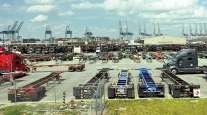El Paso, Juarez Plan Elevated Rail Shuttle to Move Trailers, Containers Cross-Border
This story appears in the Feb. 11 print edition of Transport Topics.
Officials in El Paso, Texas, and Juarez, Mexico, said they are proceeding with an elevated, electric rail shuttle to move truck trailers and intermodal freight containers across the border that separates the two cities.
Proponents of the shuttle say it would be a cost-effective method for adding an efficient cross-border freight transportation option. Skeptics counter that the shuttle is trying to fix a nonexistent problem, as slowness at the border is more of an issue of the customs process than a lack of transportation infrastructure.
“We have a major problem with traffic congestion and wait times at the border,” said Said Larbi-Cherif, director of international bridges for the city of El Paso. “This is a doable project — although it will require a lot of coordination — but it is one of the few projects on the board that can make a difference.”
He said the shuttle could be operational by 2016 or 2017.
Larbi-Cherif and Bob Cook, chief of economic development of the Borderplex Alliance for El Paso, Juarez and Las Cruces, N.M., said there is a letter of agreement in place among the two U.S. cities; Juarez, Mexico; Borderplex, an economic development agency; and Freight Shuttle International, a company led by Stephen Roop, assistant agency director of the Texas A&M Transportation Institute. FSI would be responsible for building and operating the freight shuttle, and would get paid by charging fees for providing transportation services.
Before breaking ground, the shuttle’s supporters will have to navigate the permitting processes of the U.S. and Mexican federal governments, the two El Paso official said. The support pillars for the system could be built on the grassy median of a divided highway.
Cook estimated that construction could take 24 to 36 months. Plans call for a crossing of 10 to 20 miles of elevated rail between secured terminals on either side of the border. He said about 4,400 trucks cross the border daily in the area, but he did not give estimates how much cargo could cross via the shuttle.
Celadon Group CEO Paul Will said crossing the U.S.-Mexican border is troublesome, but he does not see freight shuttles solving the problem. Celadon, Indianapolis, is the nation’s 10th-largest truckload carrier and is probably best known for its north-south cross-border routes involving either Canada or Mexico.
“When you go into Canada, it’s maybe a couple of hours delay at most, but the southern border is totally different. It’s antiquated and archaic, and you can be stuck for hours and hours,” Will said.
George Chasteen, Celadon’s vice president of Mexican operations, said much of the border infrastructure is very good, citing the World Trade Bridge between Laredo, Texas, and Nuevo Laredo, Mexico, for separating commercial vehicles from passenger traffic.
“There are already things being done at the border to improve infrastructure,” Chasteen said.
The Mexican customs clearance process through private brokerages is more the issue, Will said. He said they are similar to the taxicab medallion system in New York, with the Mexican government awarding a limited number of brokerages to be run as private businesses.
Borderplex’s Cook sees the shuttle as essential.
“There is no question in our minds this project will help alleviate congestion and allow for more throughput at the border,” he said.
Roop compared the shuttle with the passenger trams that often run between airport terminals. He has been working on the idea for 10 years, he said, and sees the track being at least 17 feet above the ground, with side-by-side tracks running in opposite directions.
Each transit vehicle on the track would be powered by an independent electric motor drawing electricity from a third rail, such as those on subways. Roop said the vehicles could hold either a trailer or a shipping container. Steel wheels on steel tracks are the lowest in rolling resistance, and emissions from electric motors are less than diesel engines, he said.
Roop said he sees two general types of applications for the shuttle: short strategic routes, such as crossing a border or leaving a port, and medium-haul routes of roughly 100 to 400 miles through congested corridors in need of more highway lanes. The maximum speed would be 62 miles per hour for a medium-haul route and about half of that for a short, strategic route.
He does not see the shuttle going longer than medium-haul, as it could not compete well with railroads. Roop also said he sees the shuttle as an option for trucking companies to use and not a replacement for trucks.
“We’ve designed this to serve over-the-road customers and logistics companies. We feel we’re a niche player,” Roop said.
American Trucking Associations also would like to improve transit times for crossing the southern border. In October, ATA Chairman Michael Card traveled to Mexico City to urge more U.S.-Mexican trade and greater efficiency.
Martin Rojas, ATA vice president of security and operations, described the slowness at the southern border as a process issue.
“Customs brokerages in Mexico are not open 24 hours a day. They might close at 5 or 6 in the evening,” said Rojas




